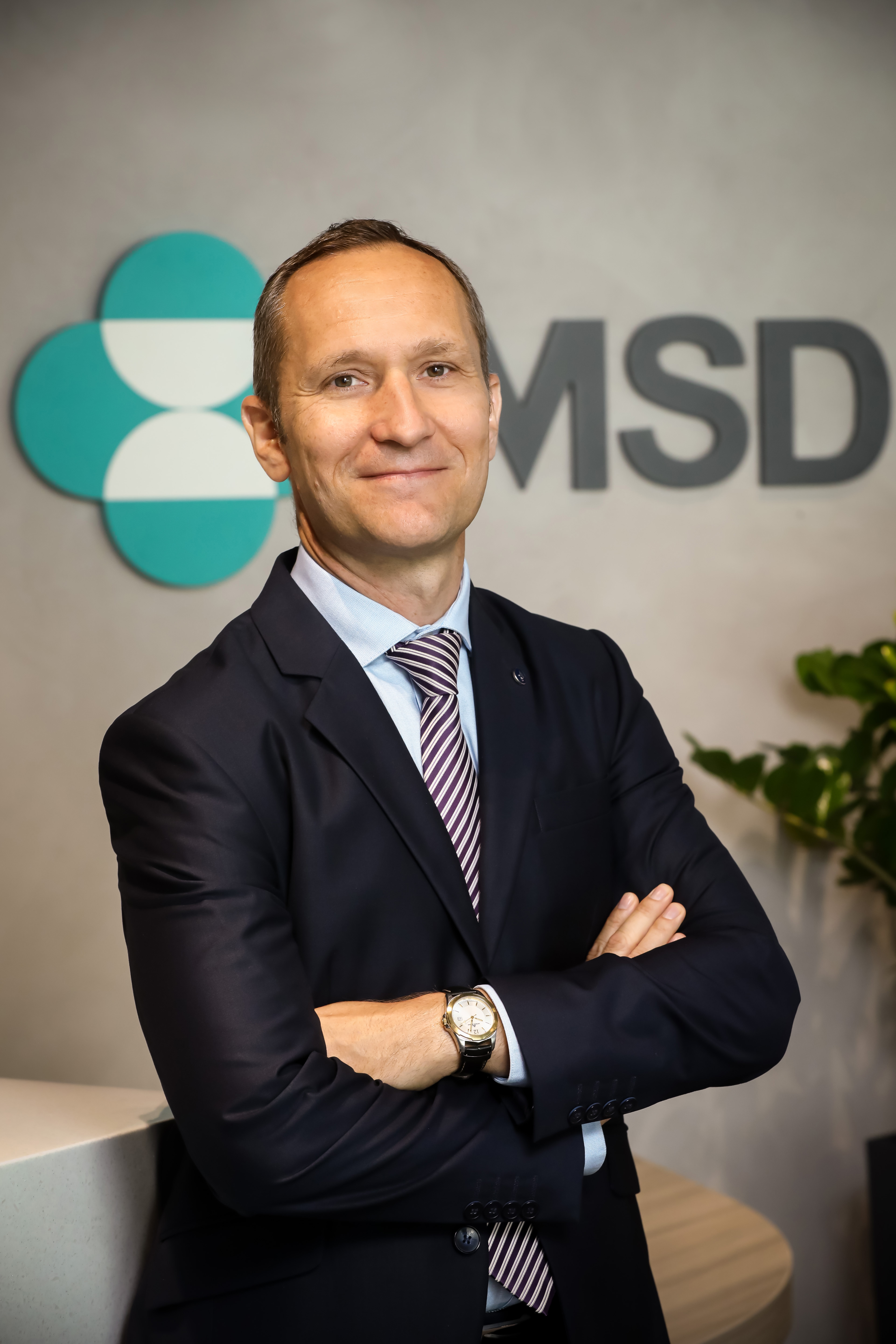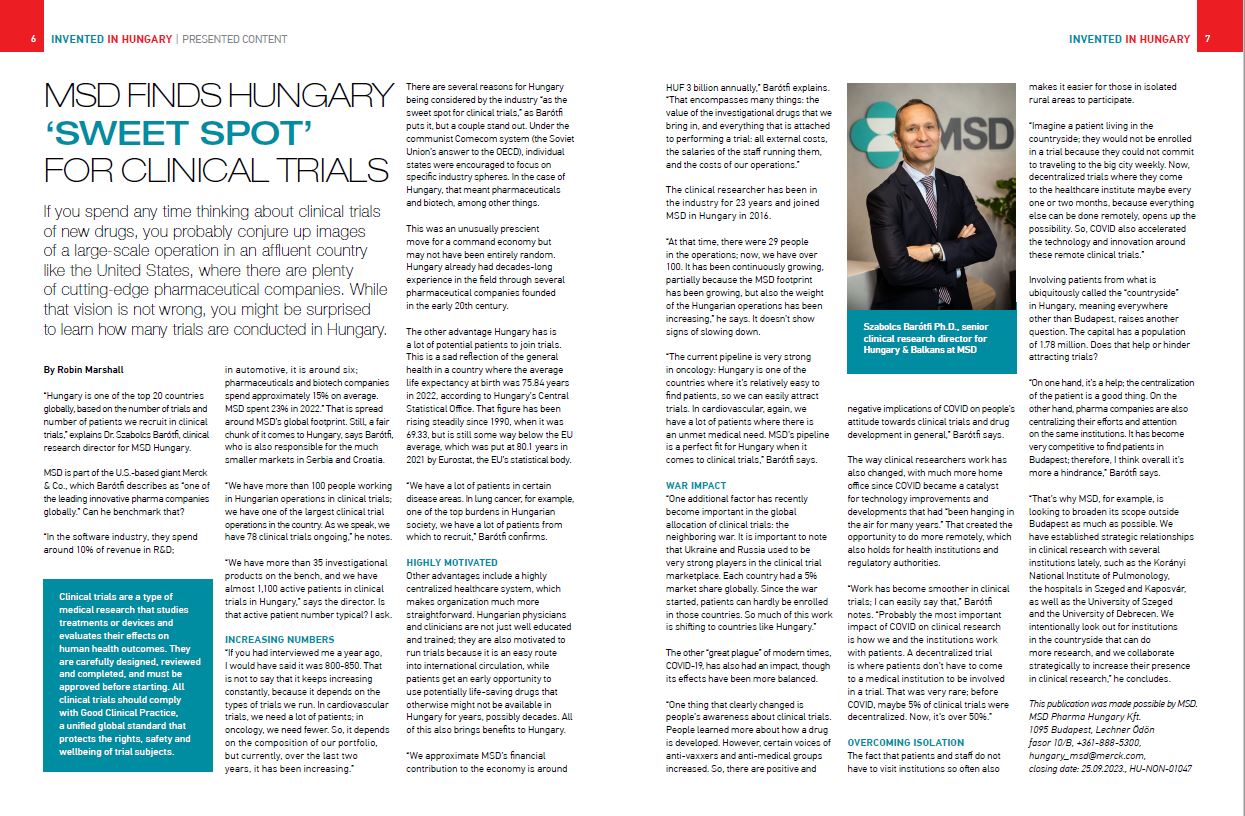MSD Finds Hungary ‘Sweet Spot’ for Clinical Trials
2023. 12. 04 13:46 GMT+0100
If you spend any time thinking about clinical trials of new drugs, you probably conjure up images of a large-scale operation in a large, affluent country like the United States, where there are plenty of cutting-edge pharmaceutical companies. While that vision is not wrong, you might be surprised to learn how many trials are conducted in Hungary.

“Clinical trials are a type of medical research that studies treatments or devices and evaluates their effects on human health outcomes. They are carefully designed, reviewed and completed, and must be approved before starting. All clinical trials should comply with Good Clinical Practice, a unified global standard that protects the rights, safety and wellbeing of trial subjects.”
“Hungary is one of the top 20 countries globally, based on the number of trials and number of patients we recruit in clinical trials,” explains Dr. Szabolcs Barótfi, clinical research director for MSD Hungary.
MSD is part of the U.S.-based giant Merck & Co., which Barótfi describes as “one of the leading innovative pharma companies globally.” Can he benchmark that?
“In the software industry, they spend around 10% of the revenue in R&D; in automotive, it is around six; pharmaceuticals and biotech companies spend approximately 15% on average. MSD spent 23% in 2022.” That is spread around MSD’s global footprint. Still, a fair chunk of it comes to Hungary, says Barótfi, who is also responsible for the much smaller markets in Serbia and Croatia.
“We have more than 100 people working in Hungarian operations in clinical trials; we have one of the largest clinical trial operations in the country. As we speak, we have 78 clinical trials ongoing,” he notes.
“We have over 35 investigational products on the bench, and we have almost 1,100 active patients in clinical trials in Hungary,” says the clinical director. Is that active patient number typical? I ask.
Increasing Numbers
“If you had interviewed me a year ago, I would have said 800-850. That is not to say that it keeps increasing constantly because it depends on the types of trials we run. In cardiovascular trials, we need a lot of patients; in oncology, we need fewer. So, it depends on the composition of our portfolio, but currently, over the last two years, it has been increasing.”
There are several reasons for Hungary being considered by the industry “as the sweet spot for clinical trials,” as Barótfi puts it, but a couple stand out. Under the communist Comecom system (the Soviet Union’s answer to the OECD), individual states were encouraged to focus on specific industry spheres. In the case of Hungary, that meant pharmaceuticals and biotech, among other things.
This was an unusually prescient move for a command economy but may not have been entirely random. Hungary already had decades-long experience in the field through a number of pharmaceutical companies founded in the early 20th century.
The other advantage Hungary has is a lot of potential patients to join trials. This is a sad reflection of the general health in a country where the average life expectancy at birth was 75.84years in 2022, according to Hungary’s Central Statistical Office. That figure has been rising steadily since 1990, when it was 69.33, but is still some way below the EU average, which was put at 80.1 years in 2021 by Eurostat, the EU’s statistical body.
“We have a lot of patients in certain disease areas. In lung cancer, for example, one of the top burdens in Hungarian society, we have a lot of patients from which to recruit,” Barótfi confirms.
Highly Motivated
Other advantages include that the healthcare system is highly centralized, which makes everything much more straightforward. Hungarian physicians and clinicians are not just well educated and trained; they are also motivated to run trials because it is an easy route into international circulation, while patients get an early opportunity to use potentially life-saving drugs that otherwise might not be available in Hungary for years, possibly decades. All of this also brings benefits to Hungary.
“We approximate MSD’s financial contribution to the economy is around HUF 3 billion annually,” Barótfi explains. “That encompasses many things: the value of the investigational drugs that we bring in, and everything that is attached to performing a trial: all external costs, the salaries of the staff running them, and the costs of our operations.”
The clinical researcher has been in the industry for 23 years and joined MSD in Hungary in 2016.
“At that time, there were 29 people in the operations; now, we have over 100. It has been continuously growing, partially because the MSD footprint has been growing, but also the weight of the Hungarian operations has been increasing,” he says. It doesn’t show signs of slowing down.
“The current pipeline is very strong in oncology: Hungary is one of the countries where it’s relatively easy to find patients, so we can easily attract trials. In cardiovascular, again, we have a lot of patients where there is an unmet medical need. MSD’s pipeline is a perfect fit for Hungary when it comes to clinical trials,” Barótfi says.
War Impact
“One additional factor has recently become important in the global allocation of clinical trials: the war. It is important to note that Ukraine and Russia used to be very strong players in the clinical trial marketplace. Each country had a 5% market share globally. Since the war started, patients can hardly be enrolled in those countries. So much of this work is shifting to countries like Hungary.”
The other “great plague” of modern times, COVID-19, has also had an impact, though it is more balanced.
“One thing that clearly changed is people’s awareness about clinical trials. People learned more about how a drug is developed. However, certain voices of anti-vaxxers and anti-medical groups increased. So, there are positive and negative implications of COVID on people’s attitude towards clinical trials and drug development in general,” he says.
The way clinical researchers work has also changed, with much more home office since COVID became a cataract for technology improvements and developments that had “been hanging in the air for many years.” That created the opportunity to do more remotely, which also holds for health institutions and regulatory authorities.
“Work has become smoother in clinical trials; I can easily say that,” Barótfi notes. “Probably the most important impact of COVID on clinical research is how we and the institutions work with patients. A decentralized trial is where patients don’t have to come to a medical institution to be involved in a trial. That was very rare; before COVID, maybe 5% of clinical trials were decentralized. Now, it’s over 50%.”
Overcoming Isolation
The fact that patients and staff do not have to visit institutions so often also makes it easier for those in isolated rural areas to participate.
“Imagine a patient living in the countryside; they would not be enrolled in a trial because they cannot commit to traveling to the big city weekly. Now, decentralized trials where they come to the healthcare institute maybe every one or two months, because everything else can be done remotely, opens up the possibility. So, COVID also accelerated the technology and innovation around these remote clinical trials.”
Involving patients from what is ubiquitously called the “countryside” in Hungary, meaning everywhere other than Budapest, raises another question. The capital has a population of 1.78 million. Does that help or hinder attracting trials?
“On one hand, it’s a help; the centralization of the patient is a good thing. On the other hand, pharma companies are also centralizing their efforts and attention on the same institutions. It has become very competitive to find patients in Budapest; therefore, I think overall it’s more a hindrance,” Barótfi says.
“That’s why MSD, for example, is looking to broaden its scope outside Budapest as much as possible. We have established strategic relationships in clinical research with a number of institutions lately, such as the Korányi National Institute of Pulmonology, the Győr Hospital as well as the University of Szeged and the University of Debrecen. We intentionally look out for institutions in the countryside that can do more research, and we collaborate strategically to increase their presence in clinical research,” he concludes.
Written by Robin Marshall for the Invented in Hungary publication.
Download the original article in PDF.

